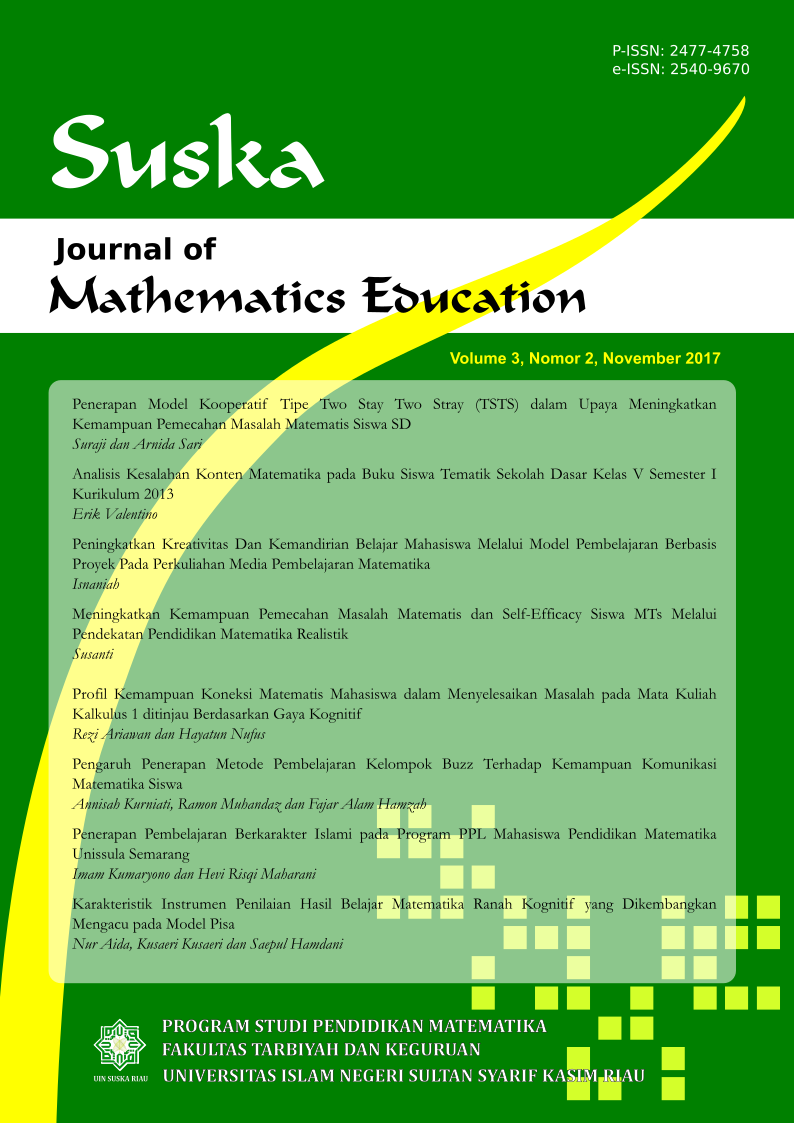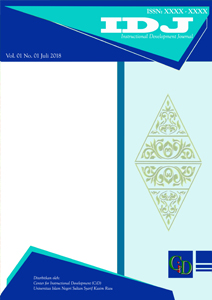Pengembangan Instrumen Kemampuan Pemecahan Masalah Matematika Siswa Menggunakan Model Rasch
Abstract
Kemampuan pemecahan masalah matematika penting dimilki oleh seluruh siswa termasuk siswa kelas V sekolah dasar, karena dapat membantu dalam menghadapi tantangan zaman dan kehidupan sehari-hari yang semakin kompleks. Penelitian ini bertujuan untuk mengetahui proses pengembangan dan validasi instrumen kemampuan pemecahan masalah matematika siswa secara psikometrika. Metode yang digunakan yaitu mixed method dengan jenis sequential exploratory yang didahului metode kualitatif dan setelah itu dikuatkan dengan metode kuantitatif. Teknik sampel yang dilakukan adalah purposive sampling. Analisis data pada penelitian ini menggunakan model rasch yang merupakan bagian dari teori respon butir (IRT) pada teori tes modern melalui aplikasi winstep. Berdasarkan hasil analisis data, dapat diketahui bahwa pada proses pengembangannya secara kualitatif, instrumen ini sudah sesuai antara indikator pemecahan masalah matematika dengan capaian dan tujuan pembelajarannya. Kemudian secara kuantitatif menurut pakar instrumen soal kemampuan masalah matematika sudah valid yang berarti telah layak untuk digunakan. Kemudian dilanjutkan dengan ujicoba lapangan pada 163 responden siswa kelas V di Jakarta Timur yang menghasilkan bahwa instrumen telah memenuhi persyaratan model rasch IRT dan dapat digunakan pada kemampuan siswa rata-rata sekitar -1 logit sampai 0 logit.
Full Text:
PDFReferences
Ahmad, N. Q., Noviani, J., & Sari, A. P. (2023). Analysis of High School Students’ Difficulties in Solving Hots Problems Using The Two-Tier Test Method. Jurnal Math Educator Nusantara: Wahana Publikasi Karya Tulis Ilmiah Di Bidang Pendidikan Matematika, 9(2), 95–110. https://doi.org/10.29407/jmen.v9i2.20822
Bond, T. G., Yan, Z., & Heene, M. (2020). Applying The Rasch Model: Fundamental Measurement in The Human Sciences. In Applying the Rasch Model: Fundamental Measurement in the Human Sciences. Taylor and Francis. https://doi.org/10.4324/9780429030499
Cahyani, H., & Setyawati, R. W. (2016). Pentingnya Peningkatan Kemampuan Pemecahan Masalah melalui PBL untuk Mempersiapkan Generasi Unggul Menghadapi MEA. In PRISMA, Prosiding Seminar Nasional Matematika.
Cai, L., Choi, K., Hansen, M., & Harrell, L. (2016). Item Response Theory. Annual Review of Statistics and Its Application, 3(1), 297–321. https://doi.org/https://doi.org/10.1146/annurev-statistics-041715-033702
Cohen, L., Manion, L., & Morrison, K. (2018). Research Methods in Education. Routledge.
Creswell, J. W., & Creswell, J. D. (2023). Research Design: Qualitative, Quantitative, and Mixed Methods Approaches (Sixth Edition). SAGE Publications.
Das Nair, R., Moreton, B. J., & Lincoln, N. B. (2011). Rasch Analysis of The Nottingham Extended Activities of Daily Living Scale. Journal of Rehabilitation Medicine, 43(10), 944–950. https://doi.org/10.2340/16501977-0858
De Ayala, R. J. (2022). The Theory and Practice of Item Response Theory (Second Edition). Guilford Publication.
Edwards, M. C., Houts, C. R., & Cai, L. (2018). A Diagnostic Procedure to Detect Departures from Local Independence in Item Response Theory Models. Psychological Methods, 23(1), 138–149. https://doi.org/10.1037/met0000121
Falissard, B. (1999). The Unidimensionality of A Psychiatric Scale: A Statistical Point of View. International Journal of Methods in Psychiatric Research, 8(3), 162–167. https://doi.org/https://doi.org/10.1002/mpr.66
Ha, H. T. (2022). Test Format and Local Dependence of Items Revisited: A Case of Two Vocabulary Levels Tests. Frontiers in Psychology, 12. https://doi.org/10.3389/fpsyg.2021.805450
Hastuti, T. A., Sari, I. P. T. P., & Andrianto, S. D. (2023). Analysis of The Aiken Index to Know The Content Validity of The Lesson Plan Evaluation Instrument on Physical Fitness Materials Viewed from Learning Strategies. In 6th Yogyakarta International Seminar on Health, Phsysical Education and Sport Science (YISHPESS 2023), 276–282. https://doi.org/10.2991/978-94-6463-356-6_31
Hendriana, H., Johanto, T., Sumarmo, U., Siliwangi Bandung, I., Terusan Jenderal Sudirman, J., Negeri, S., Jatigede, K., & Pakenjeng Kab Garut, J. (2018). The Role of Problem-Based Learning to Imporove Student’s Mathematical Problem-Solving Ability and Self Confidence. Journal on Mathematics Education, 9(2), 291–300.
Hori, K., Fukuhara, H., & Yamada, T. (2022). Item Response Theory and Its Applications in Educational Measurement Part I: Item Response Theory and Its Implementation in R. Wiley Interdisciplinary Reviews: Computational Statistics, 14(2). https://doi.org/10.1002/wics.1531
Kondratek, B. (2022). UIRT: A Command for Unidimensional IRT Modeling. Stata Journal, 22(2), 243–268. https://doi.org/10.1177/1536867X221106368
Liljedahl, P., Santos-Trigo, M., Malaspina, U., & Bruder, R. (2016). Problem Solving in Mathematics Education. Springer Nature. http://www.springer.com/series/14352
Linacre, J. M. (2010). Requests for Reprints Should be Sent to Predicting Responses from Rasch Measures. Predicting Responses from Rasch Measures, 11(1), 1–10.
Linacre, J. M. (2012). A User’s Guide to WINSTEPS Ministep : Rasch-Model Computer Programs. Winsteps.com.
Meijer, R. R., & Sijtsma, K. (2001). Methodology Review: Evaluating Person Fit. Applied Psychological Measurement, 25(2), 107–135. https://doi.org/10.1177/01466210122031957
Muslihin, H. Y., Suryana, D., Ahman, Suherman, U., & Dahlan, T. H. (2022). Analysis of the Reliability and Validity of the Self-Determination Questionnaire Using Rasch Model. International Journal of Instruction, 15(2), 207–222. https://doi.org/10.29333/iji.2022.15212a
OECD. (2023). PISA 2022 Results (Volume I). OECD. https://doi.org/10.1787/53f23881-en
Orlando, M., Health Division, R., Monica, S., & Thissen, D. (2003). Further Investigation of the Performance of S − X 2 : An Item Fit Index for Use With Dichotomous Item Response Theory Models. Applied Psychological Measurement, 27(4), 289–298. https://doi.org/10.1177/0146621603253011
Perera, C. J., Sumintono, B., & Na, J. (2018). The Psychometric Validation of The Principal Practices Quetionnaire Based on Item Response Theory. International Online Journal of Educational Leadership, 2(1), 21–38. https://doi.org/https://doi.org/10.22452/iojel.vol2no1.3
Polya, G. (1973). How T o Solve It: Vol. Second Edition. Pricenton University Press.
Rush, B. R., Rankin, D. C., & White, B. J. (2016). The Impact of Item-Writing Flaws and Item Complexity on Examination Item Difficulty and Discrimination Value. BMC Medical Education, 16(1). https://doi.org/10.1186/s12909-016-0773-3
Salwida, K., Yuanita, P., & Sakur, S. (2022). Perangkat Pembelajaran Berbasis Model Problem Based Learning untuk Memfasilitasi Kemampuan Pemecahan Masalah Matematis Peserta Didik. Journal for Research in Mathematics Learning) p, 5(1), 89–098. https://doi.org/http://dx.doi.org/10.24014/juring.v3i4.10312
Samosir, C. M., Solfitri, T., & Armis, A. (2020). Penerapan Model Pembelajaran Berdasarkan Masalah untuk Meningkatkan Kemampuan Pemecahan Masalah Matematis Siswa Kelas VII A SMP PGRI Pekanbaru Tahun Pelajaran 2019/ 2020. Journal for Research in Mathematics Learning) p, 3(4), 403–412. https://doi.org/http://dx.doi.org/10.24014/juring.v3i4.10312
Stenner, A. J., Fisher Jr, W. P., Stone, M. H., & Burdick, D. S. (2013). Causal Rasch models. Frontiers in Psychology, 4(AUG). https://doi.org/10.3389/fpsyg.2013.00536
Strachan, T., Cho, U. H., Ackerman, T., Chen, S. H., de la Torre, J., & Ip, E. H. (2022). Evaluation of the Linear Composite Conjecture for Unidimensional IRT Scale for Multidimensional Responses. Applied Psychological Measurement, 46(5), 347–360. https://doi.org/10.1177/01466216221084218
Sumintono, B. (2018). Rasch Model Measurements as Tools in Assessment for Learning. In 1st International Conference on Education Innovation (ICEI 2017), 38–42.
Sumintono, B., & Widhiarso, W. (2013). Aplikasi Model Rash untuk Penelitian Ilmu-Ilmu Sosial. Komunikata Publishing House.
Szabo, Z. K., Körtesi, P., Guncaga, J., Szabo, D., & Neag, R. (2020). Examples of Problem-Solving Strategies in Mathematics Education Supporting The Sustainability of 21st-Century Skills. Sustainability (Switzerland), 12(23), 1–28. https://doi.org/10.3390/su122310113
Virgia, Z., Granita, & Nelson, Z. (2019). Pengaruh Penerapan Strategi Metakognitif terhadap Kemampuan Pemahaman Konsep dan Pemecahan Masalah Matematis Siswa SMP. Journal for Research in Mathematics Learning), 2(4), 371–379. https://doi.org/http://dx.doi.org/10.24014/juring.v2i4.8566
Yayuk, E., & As’Ari, A. R. (2020). Primary School Students’ Creative Thinking Skills in Mathematics Problem Solving. European Journal of Educational Research, 9(3), 1281–1295. https://doi.org/10.12973/eu-jer.9.3.1281
DOI: http://dx.doi.org/10.24014/juring.v8i1.34022
Refbacks
- There are currently no refbacks.
Juring (Journal for Research in Mathematics Learning)
Universitas Islam Negeri Sultan Syarif Kasim Riau
Indexed by:













